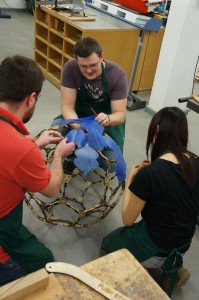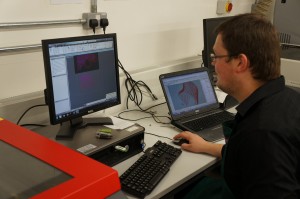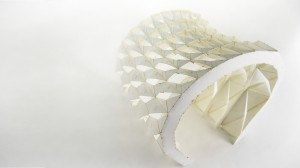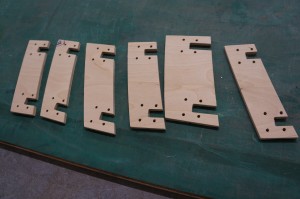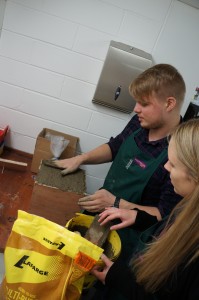Tag Archives: concrete casting
Guest Lecture: Dr Dawn Pereira – Concrete Too is Beautiful….
To give it it’s full title, ‘Concrete Too is Beautiful; How William Mitchell’s Casting Process Humanised Post-war Urban Landscapes’ will be presented by Dr Dawn Pereira next Monday, April 12th at 17.00.
The lecture will look at the fascinating abstract work of designer/sculptor William Mitchell (1925 – 2020) who is known, although certainly not well enough, for his use of concrete casting around infrastructure, in architecture and as public artworks in the UK and beyond.
Dr Dawn Pereira is an expert on Mitchells works and will tell the story of his origins, evolution and crafting process. The lecture will be followed by an open Q & A.
This lecture is part of the ‘B.15 Moulding and Casting 101’ course but is free and open to all.
Please join us here on Zoom at 17.00 on Monday April 12th.
Note that the lecture will be recorded.
Image of Leigh Turnpike Centre provided by Richard Brook.
Easter Break 2021: ‘B.15 Moulding and Casting 101’ Short-course
*******************THIS COURSE IS NOW FULLY SUBSCRIBED***************************
Dear MSA Students
We’re pleased to bring to you an open-ended short course in moulding and casting basics. This course is designed to let you take part in the process of basic relief casting over 3 practical stages from home, and in person at B.15 when safe to do so.
Due to the current restrictions and widespread locations of you all we are offering the course in a blended format, part remotely and part completed in person when circumstances allow. With this in mind we are asking those who are interested to fill out their details to apply to take part.
The course will start on 12th April 2021 with an introduction and guest lecture followed by a series of drop-in sessions. These will include a CPD with Jesmonite, zoom drop-in’s and pre-booked controlled workshop access either during the two week course delivery time or later when you are able to be in the city.
Students will learn how to carry out the following:
- Design a relief form suitable for block-moulding using silicone.
- Design formwork for a one-use block-mould using greyboard.
- Mix and pour Silicone.
- Mix and pour a casting medium (Plaster, Jesmonite, Concrete or all 3).
The course is open to MSA BA, MArch and MA A+U Students and is limited in capacity so sign up soon to avoid disappointment.
*******************THIS COURSE IS NOW FULLY SUBSCRIBED***************************
The course is free although some materials/tool purchases may be required for home working, individual circumstance pending. Full details will be provided after your application is complete.
Your application will be reviewed and if necessary we’ll be in touch to clarify your situation before offering you a place.
We look forward to hearing from you!
Scott & Saul
Pavilions…..
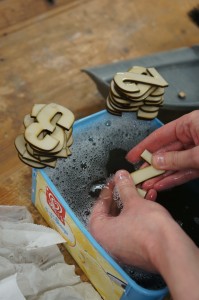 Danielle Foster and Patrick Gorman have begun making their moulds for concrete casting which will take place at the Sheds over the coming weeks. The actual concrete casting process will be time consuming and potentially costly so spending time to get the moulds right is essential.Â
Danielle Foster and Patrick Gorman have begun making their moulds for concrete casting which will take place at the Sheds over the coming weeks. The actual concrete casting process will be time consuming and potentially costly so spending time to get the moulds right is essential. 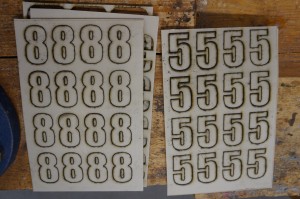 Myself and Jim spent almost two days cutting components on our circular saw to make the moulds for the blocks. each mould will produce a positive and a negative indent to allow each brick to fit together. Each brick will also be numbered using the rubber number profiles the group tested at the previous stage of development. Cutting this material takes a little practice before going ahead to cut hundreds of components. The rubber had a tendency to melt and blacken as it was cut meaning that cleaning was required post cutting.
Myself and Jim spent almost two days cutting components on our circular saw to make the moulds for the blocks. each mould will produce a positive and a negative indent to allow each brick to fit together. Each brick will also be numbered using the rubber number profiles the group tested at the previous stage of development. Cutting this material takes a little practice before going ahead to cut hundreds of components. The rubber had a tendency to melt and blacken as it was cut meaning that cleaning was required post cutting.
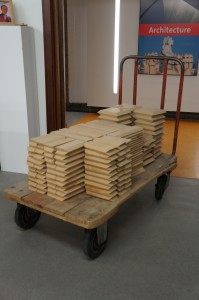 Hopefully we’ll start to see some of the finished components coming in the next few weeks. We’ll post an update when we do.
Hopefully we’ll start to see some of the finished components coming in the next few weeks. We’ll post an update when we do.
 Further testing was required in Alexander Valakh and Lorena Chan’s design following some material and assembly issues.Â
Further testing was required in Alexander Valakh and Lorena Chan’s design following some material and assembly issues. 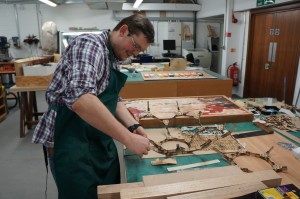

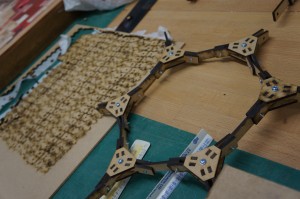
 Once the main structural form was complete Alex and Lorena were able to test the ‘skin’ components that started life being inspired by poppies. At this stage they are still unsure about the exact material that will be used to create this component. This project has been given the green light along with the concrete blocks so we can expect more posts from both of these projects in the next weeks/months.
Once the main structural form was complete Alex and Lorena were able to test the ‘skin’ components that started life being inspired by poppies. At this stage they are still unsure about the exact material that will be used to create this component. This project has been given the green light along with the concrete blocks so we can expect more posts from both of these projects in the next weeks/months.
Pavilion Development Continues
The development of the Dunham Massey Pavilions has been slowly progressing over the last two months with many different problems to overcome. Many of the original concepts have changed in scale and style whilst others have remained largely unchanged.
For Alexander Valakh and Lorena Chan the main problems have come from various material tolerances effect on their designs.
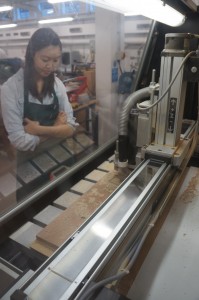
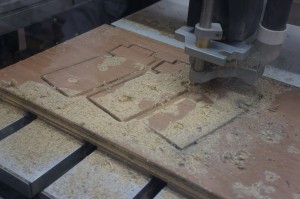
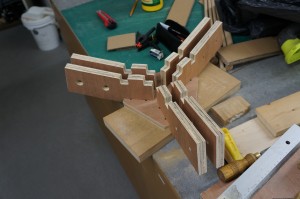 The group used the CNC router to cut plywood components for this phase of their design development. The original poppy concept that was made from cardboard and the riveted elements allowed a lot of flex. When applying the same ideas to a more durable and weather resistant material the same shapes could not be achieved. This is where 1:1 design development models come into use.
The group used the CNC router to cut plywood components for this phase of their design development. The original poppy concept that was made from cardboard and the riveted elements allowed a lot of flex. When applying the same ideas to a more durable and weather resistant material the same shapes could not be achieved. This is where 1:1 design development models come into use.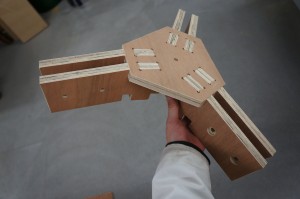 To test the strength of each joint for their revised design the group decided to risk lorenas life lorena to the task. Luckily their design proved successful and despite a few oversights in fixing elements which can easily be rectified, the group can move on.
To test the strength of each joint for their revised design the group decided to risk lorenas life lorena to the task. Luckily their design proved successful and despite a few oversights in fixing elements which can easily be rectified, the group can move on.
 After the experimental first test in concrete casting, it was nesissary for this group to solve the issues of casting their numbers into each block. For their second attempt they tried using laser cut rubber components with a much smaller block to prevent material waste and save on weight.Â
After the experimental first test in concrete casting, it was nesissary for this group to solve the issues of casting their numbers into each block. For their second attempt they tried using laser cut rubber components with a much smaller block to prevent material waste and save on weight.  Any mould is always worth considering in depth as a badly designed one will cause you a world of problems when you come to remove your cast. This box was simple but constructed well to allow easy disassembly once the cast has cured.Â
Any mould is always worth considering in depth as a badly designed one will cause you a world of problems when you come to remove your cast. This box was simple but constructed well to allow easy disassembly once the cast has cured. 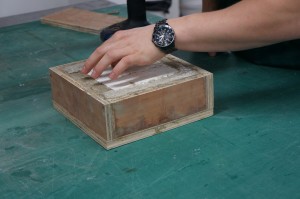
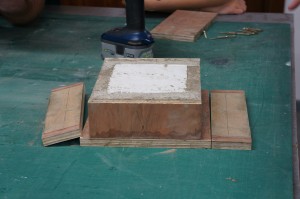 The finished block turned out well with the flex in the rubber numbers allowing for the expansion of the concrete as it sets. Laser cutting this material can prove time consuming and the number required may need to be outsourced due to demand on our machines from all Architecture Students. It is always worth considering outsourcing elements that need to be mass produced as if you are involved in a ‘real world’ project. Costs can often be lower and experienced companies will be able to offer you more specific advice on what you are trying to achieve at 1:1. We’ll be posting more on these project in the near future!Â
The finished block turned out well with the flex in the rubber numbers allowing for the expansion of the concrete as it sets. Laser cutting this material can prove time consuming and the number required may need to be outsourced due to demand on our machines from all Architecture Students. It is always worth considering outsourcing elements that need to be mass produced as if you are involved in a ‘real world’ project. Costs can often be lower and experienced companies will be able to offer you more specific advice on what you are trying to achieve at 1:1. We’ll be posting more on these project in the near future! 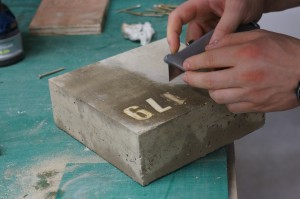
Garden Pavilions Continued – Learning Curves and Problem Solving
Development of the 6th year pavilion projects is continuing at pace down in the workshop. Test models often bring assembly issues to the surface which Alexander Valakh, Lorena Chan and Nancy Chan have been finding with their concepts. This is exactly why these models play a vital role in design development.  Here Alex has created his outer skin from laser cut polypropylene plastic sheet fixed with pop rivets. This has proved tricky and mid way through assembly it became clear that a more uniform stapled fixing would have been more effective.Â
Here Alex has created his outer skin from laser cut polypropylene plastic sheet fixed with pop rivets. This has proved tricky and mid way through assembly it became clear that a more uniform stapled fixing would have been more effective. 
 Lorena and Nancy have spent the last few days fixing components for this concept together. The original concept was to have a smooth curved structure forming the tunnel walkway. As the components were fixed the group found that the curve was un-uniform due to the varying strain between components. Whilst this isn’t exactly how the concept was drawn it has still proved an interesting experiment and may still be taken to the next stage.
Lorena and Nancy have spent the last few days fixing components for this concept together. The original concept was to have a smooth curved structure forming the tunnel walkway. As the components were fixed the group found that the curve was un-uniform due to the varying strain between components. Whilst this isn’t exactly how the concept was drawn it has still proved an interesting experiment and may still be taken to the next stage.

 The concrete cast (below) has also had some teething problems with the cast numbers not turning out as refined as the group would have liked. This process will require more thought if it is to be taken forward. The group has found that their choice of aggregate or quantity used may be to blame for the irregular casting around the number details. One thing is for sure it wont be going too far given its weight despite having a polystyrene block inside to reduce the material used!
The concrete cast (below) has also had some teething problems with the cast numbers not turning out as refined as the group would have liked. This process will require more thought if it is to be taken forward. The group has found that their choice of aggregate or quantity used may be to blame for the irregular casting around the number details. One thing is for sure it wont be going too far given its weight despite having a polystyrene block inside to reduce the material used!
Garden Pavilions at Dunham Massey 2013
Much like the brief set this time last year students are currently in the concept stages of designing a series of pavilions to be constructed at 1:1 at Dunahm Massey (Read our blog post here). This project was challenging for both staff and students last year and really pushed the boundaries of what the workshops can handle.
This year the project is aiming to be more refined and, with support of workshop staff, come to an effective and ‘speed-bump’ free conclusion!
Alexander Valakh (Below) is working on several sketch models to help convey his project named ‘The Shadow of War’ to tutors in the hope it will be taken to the next stage of development.
To test his theory for eventual 1:1 construction Alex had produced a plywood sketch model in identical fashion to the full size proposal on our CNC. Producing this model has allowed Alex to explore problems he may encounter whilst using this method and has already identified several areas that will need more thought. These issues are not a hindrance to the design process but feed into it and shouldn’t be seen as a waste of time. problem solving through trial and error models are often the best way of refining a design for production.
This group is also producing another concept pavilion using paper to create the sketch model. The flower-like components are created and joined using pop rivets which will eventually form a curved canopy. 
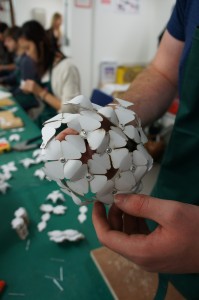
Another (!) concept from the same group involves casting concrete blocks as part of a wall sculpture. This is part of the same brief but is less interactive due to the nature of the proposed site. This was poured yesterday afternoon and is still setting so we’ll hopefully have some more pictures of how that is progressing by the end of the week.



